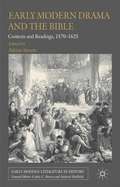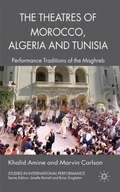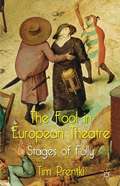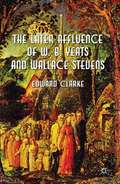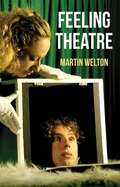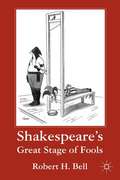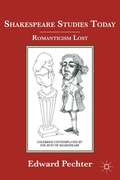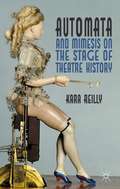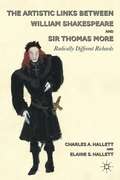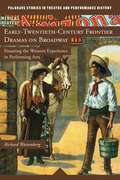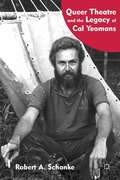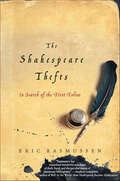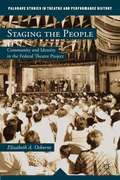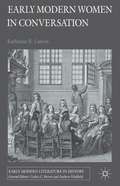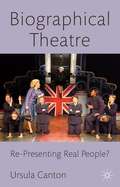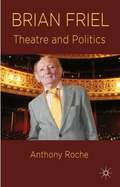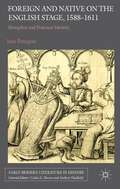- Table View
- List View
Sex and Aesthetics in Samuel Becketts Work (New Interpretations of Beckett in the Twenty-first Century)
by Paul StewartThis book places sex and sexuality firmly at the heart of Beckett. From the earliest prose to the late plays, Paul Stewart uncovers a profound mistrust of procreation which nevertheless allows for a surprising variety of non-reproductive forms of sex which challenge established notions of sexual propriety and identity politics.
Shakespeare’s Speculative Art
by Maurice A. HuntThis is the first book-length analysis of Shakespeare s depiction of specula (mirrors) to reveal the literal and allegorical functions of mirrors in the playwright s art and thought. Adding a new dimension to the plays Troilus and Cressida, Julius Caesar, Macbeth, Hamlet, King Henry the Fifth, Love s Labor s Lost, A Midsummer Night s Dream, and All s Well That Ends Well, Maurice A. Hunt also references mirrors in a wide range of external sources, from the Bible to demonic practices. Looking at the concept of speculation through its multiple meanings - cognitive, philosophical, hypothetical, and provisional - this original reading suggests Shakespeare as a craftsman so prescient and careful in his art that he was able to criticize the queen and a former patron with such impunity that he could still live as a gentleman.
Early Modern Drama and the Bible
by Adrian StreeteEarly modern drama is steeped in biblical language, imagery and stories. This collection of essays examines the extensive and pervasive presence of scripture on the early modern stage and considers a range of plays by writers such as Shakespeare, Marlowe, Middleton, Webster, Massinger and Heywood. The introduction situates the religious, political and ideological contexts within which the relationship between stage and book was negotiated. The individual essays then explore a variety of dramatic encounters with scripture, ranging from material and verbal presences, iconoclasm, political theology, the Bible and the law, the domestic, the religious and political controversy. In this way, the capacious and widespread dramatic engagement with the early modern Bible is reconsidered. These essays offer fresh and exciting readings of early modern drama by resituating the theatre as a site of public and communal engagement with, and interrogation of, scripture.
The Theatres of Morocco, Algeria and Tunisia
by Marvin Carlson Khalid AmineModern international studies of world theatre and drama have begun to acknowledge the Arab world only after the contributions of Asia, Africa and Latin America. Within the Arab world, the contributions of Algeria, Tunisia, and Morocco to modern drama and to post-colonial expression remain especially neglected, a problem that this book addresses.
The Fool in European Theatre
by Tim PrentkiWhy is folly essential to the functioning of a healthy society? Why is theatre a natural home for madness? The answers take the reader on a journey embracing Shakespeare and Jonson, Brecht and Beckett, B#65533;chner and Boal. From Falstaff to Fo via Figaro, this study examines the art of telling truth to power and surviving long enough to have a laugh.
The Later Affluence of W. B. Yeats and Wallace Stevens
by Edward ClarkeSurveying the later work of W. B. Yeats and Wallace Stevens, Edward Clarke unfolds their very last poems and considers the two poets' relations with western literature and tradition. This book shows how these two latecomers transform the ways in which we read earlier poets.
Feeling Theatre
by Martin WeltonWhy is it that in going to see plays we are also touched or moved by them, and is there more than metaphor involved in such claims? Considering these and other questions, this book examines a range of contemporary performance works in which performers and their audiences occupy a shared realm of feelings, in which the play is not always the thing.
Shakespeare's Great Stage of Fools
by Robert H. BellThis lively, lucid book undertakes a detailed and provocative study of Shakespeare's fascination with clowns, fools, and fooling. Through close reading of plays over the whole course of Shakespeare's theatrical career, Bell highlights the fun, wit, insights, and mysteries of some of Shakespeare's most vibrant and often vexing figures.
Shakespeare Studies Today
by Edward PechterThe Romantics invented Shakespeare studies, and in losing contact with our origins, we have not been able to develop an adequate alternative foundation on which to build our work. This book asserts that among Shakespeareans at present, the level of conviction required to sustain a healthy critical practice is problematically if not dangerously low, and the qualities which the Romantics valued in an engagement with Shakespeare are either ignored these days or fundamentally misunderstood.
Automata and Mimesis on the Stage of Theatre History
by Kara ReillyThe automaton, known today as the robot, can be seen as a metaphor for the historical period in which it is explored. Chapters include examinations of Iconoclasm's fear that art might surpass nature, the Cartesian mind/body divide, automata as objects of courtly desire, the uncanny Olympia, and the revolutionary Robots in post-WWI drama.
Urban Drama
by J. Chris WestgateIdentifying an apprehension about the nature and constitution of urbanism in North American plays, Westgate examines how cities like New York City and Los Angeles became focal points for identity politics and social justice at the end of the twentieth century, and how urban crises inform the dramaturgy of contemporary playwrights.
The Artistic Links Between William Shakespeare and Sir Thomas More
by Charles A. Hallett Elaine S. HallettApproaching the subject from a dramaturgical point of view, this investigation differs from anything that has been written about the relationship between Thomas More and William Shakespeare. This book defines, in specific terms, what Shakespeare learned from his study of More's "History"and how he exploited that knowledge to heighten the drama. "
Early-Twentieth-Century Frontier Dramas on Broadway
by Richard WattenbergFrontier dramas were among the most popular and successful of early-twentieth-century Broadway type plays. The long runs of contemporary dramas not only indicate the popularity of these plays but also tell us that these plays offered views about the frontier that original audiences could and did embrace.
Queer Theatre And The Legacy Of Cal Yeomans
by Robert A. SchankeA forgotten yet award-winning playwright, Cal Yeomans was one of the founders of gay theater whose work was fueled by gay liberation and extinguished by the AIDS epidemic. Schanke's examination of his life and legacy allows a rare exploration into this pivotal moment of gay American history.
Russian Culture and Theatrical Performance in America, 1891–1933
by Valleri J. HohmanBetween the 1890s and the 1930s, advancements in communication and travel encouraged widespread international cultural exchange, and Americans increasingly came into contact with Russian culture and theatrical performance. A number of factors, including emigration from Russia, world war, revolutionary activities in both Russia and the United States, and developments in modernism in the American theatre influenced the way those performances were received by American artists and audiences. Examining the work of impresarios, financiers, and the press as well as the artists themselves, Hohman demonstrates how a variety of Russian theatrical styles were introduced and incorporated into American theatre and dance.
The Shakespeare Thefts: In Search of the First Folios
by Eric RasmussenPart literary detective story, part Shakespearean lore, The Shakespeare Thefts will charm the Bard's many fans.The first edition of Shakespeare's collected works, the First Folio, published in 1623, is one of the most valuable books in the world and has historically proven to be an attractive target for thieves. Of the 160 First Folios listed in a census of 1902, 14 were subsequently stolen-and only two of these were ever recovered. In his efforts to catalog all these precious First Folios, renowned Shakespeare scholar Eric Rasmussen embarked on a riveting journey around the globe, involving run-ins with heavily tattooed criminal street gangs in Tokyo, bizarre visits with eccentric, reclusive billionaires, and intense battles of wills with secretive librarians. He explores the intrigue surrounding the Earl of Pembroke, arguably Shakespeare's boyfriend, to whom the First Folio is dedicated and whose personal copy is still missing. He investigates the uncanny sequence of events in which a wealthy East Coast couple drowned in a boating accident and the next week their First Folio appeared for sale in Kansas. We hear about Folios that were censored, the pages ripped out of them, about a volume that was marked in red paint-or is it blood?-on every page; and of yet another that has a bullet lodged in its pages.
Staging the People
by Elizabeth A. OsborneThe Federal Theatre Project stands alone as the only national theatre in the history of the United States. This study re-imagines this vital moment in American history, considering the Federal Theatre Project on its own terms - as a "federation of theatres" designed to stimulate new audiences and create locally-relevant theatre during the turbulent 1930s. It integrates a wealth of previously undiscovered archival materials with cultural history, delving into regional activities in Chicago, Boston, Portland, Atlanta, and Birmingham, as well as tours of refugee camps and Civilian Conservation Corps Divisions. For a brief, exhilarating moment, the Federal Theatre Project created a democratic theatre that staged the American people.
Early Modern Women in Conversation
by Katherine R. LarsonTo converse is, in its most fundamental sense, to engage with society. The potency of conversation as an early modern social networking tool is complicated, however, both by its gendered status in the period and by its conflation of verbal and physical interaction. Conversation was an embodied act that signified social intimacy, cohabitation, and even sexual intercourse. As such, conversation posed a particular challenge for women, whose virtuous reputation was contingent on sexual and verbal self-control. Early Modern Women in Conversation considers how five women writers from the prominent Sidney and Cavendish families negotiated the gendered interrelationship between conversation and the spatial boundaries delimiting conversational encounters to create opportunities for authoritative and socially transformative utterance within their texts. Conversation emerges in this book as a powerful rhetorical and creative practice that remaps women's relationship to space and language inearly modern England.
Biographical Theatre
by Ursula CantonMarilyn Monroe, Vincent van Gogh or the victims of rendition flights - the number and variety of historical and contemporary figures represented on British stages is amazing. This book develops a new theoretical framework for the representation of real life figures on stage and examines different ways in which they can be included in performances.
Brian Friel
by Anthony RocheFriel is recognised as Ireland's leading playwright and due to the ability of plays like Translations and Dancing at Lughnasa to translate into other cultures he has made a major impact on world theatre. This study draws on the Friel Archive to deepen our understanding of how his plays were developed.
Re-Visioning Lear’s Daughters
by Lesley Kordecki Karla KoskinenKing Lear is believed by many feminists to be irretrievably sexist. Through detailed line readings supported by a wealth of critical commentary, Re-Visioning Lear's Daughters reconceives Goneril, Regan, and Cordelia as full characters, not stereotypes of good and evil.
Performing Bodies in Pain
by Marla CarlsonThis text analyzes the cultural work of spectacular suffering in contemporary discourse and late-medieval France, reading recent dramatizations of torture and performances of self-mutilating conceptual art against late-medieval saint plays.
Shakespearean Neuroplay
by Amy Cook"Shakespearean Neuroplay" provides a methodology for applying cognitive science to the study of drama and performance. With Shakespeare's "Hamlet" as a test subject and the cognitive linguistic theory of conceptual blending as a tool, Cook unravels the "mirror held up to nature" at the center of Shakespeare's play. Hamlet's mirror becomes a conceptual structure that invisibly scaffolds our understanding of the play. A lucid explanation of both contemporary science and "Hamlet," "Shakespearean Neuroplay" unveils Shakespeare's textual theatrics and sheds light on blind spots in theatre and performance theory.
Extramural Shakespeare
by Denise AlbaneseThis study argues that Shakespeare can now be understood as part of public culture. Thanks to the emergence of mass education in the twentieth century, Albanese argues that Shakespeare has become a shared property, despite the depiction of his texts as 'elite' cultural objects in the film industry.
Foreign and Native on the English Stage, 1588-1611
by Jane PettegreeThis original and scholarly work uses three detailed case studies of plays - Shakespeare's Antony and Cleopatra , King Lear and Cymbeline - to cast light on the ways in which early modern writers used metaphor to explore how identities emerge from the interaction of competing regional and spiritual topographies.

